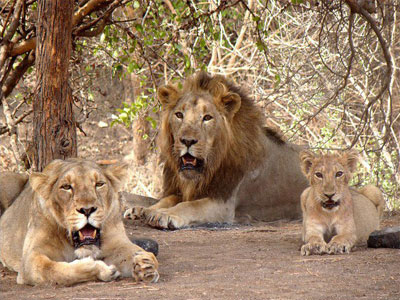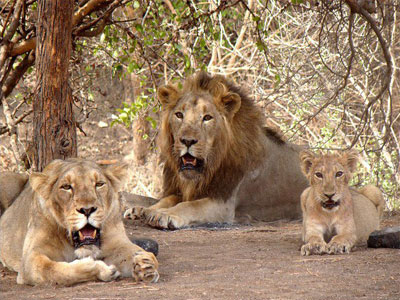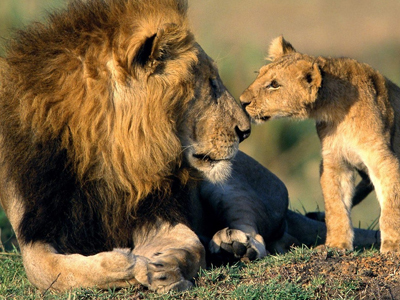
About Kanha National Park
The lush sal and bamboo forests, grassy meadows and ravines of Kanha provided inspiration to Rudyard Kipling for his famous novel "Jungle Book". The Kanha National Park in Madhya Pradesh came into being in 1955 and forms the core of the Kanha Tiger Reserve, created in 1974 under Project Tiger. The Park's landmark achievement is the preservation of the rare hardground Swamp Deer (Barasingha), saving it from near extinction. Stringent conservation programs for the overall protection of the Park's fauna and flora, makes Kanha one of the most well maintained National Parks in Asia.
A heightened attraction within the Park is Bamni Dadar, popularly known as Sunset Point that offers the most awe-inspiring backdrop of the sunset against grazing Sambhars and Gaurs, magnifying the natural splendor of the area. Aside from its diverse wildlife and bird population, the frequent sightings of Tigers roaming in the wild at Kanha Wildlife Sanctuary remain the most popular draw.
Attractions of Kanha Wildlife Sanctuary
Wildlife in the Park
The main wildlife attractions in the park are tiger, bison, gaur, sambhar, chital, barasingha, barking deer, black deer, black buck, chousingha, nilgai, mouse deer, sloth bear, jackal fox, porcupine, hyena, jungle cat, python, pea fowl, hare, monkey, mongoose, tiger, and leopard.
Birds Species in the Park
The birds species in the park include storks, teals, pintails, pond herons, egrets, peacock, pea fowl, jungle fowl, spur fowl, partridges, quails, ring doves, spotted parakeets, green pigeons, rock pigeons, cuckoos, papihas, rollers, bee-eater, hoopoes, drongos, warblers, kingfishers, woodpeckers, finches, orioles, owls, and fly catchers.
Unique Attraction - Barasingha
However, if one animal species were to represent Kanha, it would probably be the barasingha, or the swamp deer. The barasinghas at Kanha are unique, being the hard ground variety, which populate the large open tracts of grass amidst the forests of teak and bamboo. Twenty years ago, the Barasingha was faced with extinction but some desperate measures including the fencing-off of some animals helped save them and again the air in Kanha bugle with their rutting calls.
There is a museum at Kanha depicting attributes and activities of the park and tribal culture. It is closed every Wednesday.
Best Time to Visit Kanha Tiger Reserve is closed to visitors during the monsoon months, from July to November. Winter, between November and January, is a comfortable time to visit the park, when the weather’s pleasant. April to June is when the summer sets in; it can get pretty hot at this time, but if you’re a die-hard wildlife fan, this is when a visit can reward you with satisfactory wildlife-watching at the park’s waterholes.
General Information
Visitors are advised to reach the gate half an hour in advance to complete the formalities for entry into the park. Entry fee is Rs. 2 for adults and Re. 1 for children. For the entry of vehicles, the fee is Rs 15 for minibuses and vans, and Rs. 10 for light motor vehicles like cars and jeeps. Photography is free for still cameras, but a fee of Rs 10-200 is charged for video and movie cameras depending upon the aperture used. The charges for guides range from Rs. 3 to Rs. 5 depending upon the number of tourists.
How to get there?
By Air: Nagpur at 266-kms is the nearest Airport to visit Kanha National Park and is connected by various domestic airline services with Mumbai.
By Rail: Jabalpur at 169-kms is the convenient rail head to visit Kanha.
By Road: Kanha National Park is connected by road with Jabalpur 175-kms, Khajuraho 445-kms, Nagpur 266-kms, Mukki 25-kms, Raipur 219-kms. Within the park: Koshi - Kanha (9-kms), Kishi - Katia (4-kms), Kishi - Mukki (32-kms). There are regular to and fro bus service available from Jabalpur to Kanha.
Local Transport: The Madhya Pradesh State Tourism Development Corporation (MPSTDC) operates a Jeep Service for visitors to go around in the park. Advance bookings can be made through the Manager, MPSTDC, Log huts, Kisli. Wild Chalet Resorts at Village Mocha, Kanha can also arrange for local sightseeing


Best Time to Visit
Kanha Tiger Reserve is closed to visitors during the monsoon months, from July to November. Winter, between November and January, is a comfortable time to visit the park, when the weather’s pleasant. April to June is when the summer sets in; it can get pretty hot at this time, but if you’re a die-hard wildlife fan, this is when a visit can reward you with satisfactory wildlife-watching at the park’s waterholes.
General Information
Visitors are advised to reach the gate half an hour in advance to complete the formalities for entry into the park. Entry fee is Rs. 2 for adults and Re. 1 for children. For the entry of vehicles, the fee is Rs 15 for minibuses and vans, and Rs. 10 for light motor vehicles like cars and jeeps. Photography is free for still cameras, but a fee of Rs 10-200 is charged for video and movie cameras depending upon the aperture used. The charges for guides range from Rs. 3 to Rs. 5 depending upon the number of tourists.
How to get there?
By Air: Nagpur at 266-kms is the nearest Airport to visit Kanha National Park and is connected by various domestic airline services with Mumbai.
By Rail: Jabalpur at 169-kms is the convenient rail head to visit Kanha.
By Road: Kanha National Park is connected by road with Jabalpur 175-kms, Khajuraho 445-kms, Nagpur 266-kms, Mukki 25-kms, Raipur 219-kms. Within the park: Koshi - Kanha (9-kms), Kishi - Katia (4-kms), Kishi - Mukki (32-kms). There are regular to and fro bus service available from Jabalpur to Kanha.
Local Transport: The Madhya Pradesh State Tourism Development Corporation (MPSTDC) operates a Jeep Service for visitors to go around in the park. Advance bookings can be made through the Manager, MPSTDC, Log huts, Kisli. Wild Chalet Resorts at Village Mocha, Kanha can also arrange for local sightseeing